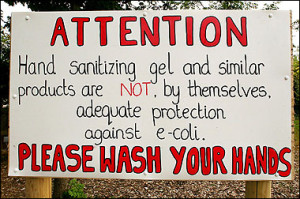Seems like Larry has taken up the throne of food safety dude in Canada.
 I remember the days when I taught Larry and Kevin Allen – who’s been sidelined by a concussion but is still a hockey goon at heart – the basics of risk analysis at the University of Guelph.
I remember the days when I taught Larry and Kevin Allen – who’s been sidelined by a concussion but is still a hockey goon at heart – the basics of risk analysis at the University of Guelph.
I have other NSFV Larry stories, but will leave those for another day.
Priscilla Hwang of CBC News reports Yellowknife’s restaurant inspectors have been checking off the “not-observed” box on their inspection sheets, indicating they’re not seeing handwashing in over a quarter of all city restaurants and food-handling locations.
That means workers in one in four food locations in Yellowknife are not checked by inspectors to see if they’re complying with one of the critical inspection items — “hands clean and properly washed,” according to a CBC News analysis of the territory’s most recent restaurant inspection data.
“It seems like not only are those critical things not followed by the restaurant, but the inspectors themselves are not necessarily looking for them or spending long enough time to observe them,” says Lawrence Goodridge, a food safety professor at McGill University.
“And in my opinion, handwashing is probably the most important part of food safety.”
Goodridge says workers generally need to wash their hands frequently, especially after touching something that may contaminate them, or after using the washrooms.
He cites one U.S. study that suggests restaurant employees should wash their hands 29 times per hour. “So, you tell me,” he chuckles.
Goodridge admits the critical things, like handwashing, are more difficult to observe and “are the ones that tend to be missed.” But he says that handwashing is right at the top of the critical list.
“They should stay long enough to see all the critical points in the inspection are being met, at the least,” says Goodridge.
More than a quarter of the city’s restaurants also received “not observed” status for proper sanitizing and storing of cloths used for wiping tables and dirty dishes, a non-critical item on the list.












